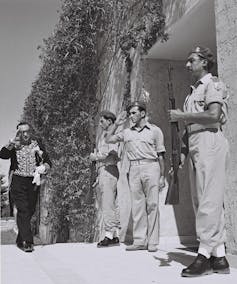Source: – By Lina Kennouche, Chercheuse associée au CREAT, Université de Lorraine
Parallèlement aux opérations en Iran et à Gaza, Israël poursuit une guerre de basse intensité au Liban, dans l’objectif d’obtenir un désarmement complet du Hezbollah. Mais l’attaque sur l’Iran, surtout maintenant que Washington s’y est ouvertement associé, pourrait avoir des effets majeurs sur toute la région, où des alignements anciens pourraient rapidement évoluer…
Depuis plusieurs mois, parallèlement à la poursuite à Gaza d’une guerre sans limite qui transgresse toutes les normes juridiques et morales, Israël intensifie sa projection de puissance sur plusieurs théâtres.
Justifiant son expansionnisme territorial par l’argument sécuritaire, Israël a étendu dès décembre 2024 son occupation du plateau du Golan, renforcé son emprise sur cinq sites stratégiques au Sud-Liban en menant des frappes de drones et d’artillerie, et conduit depuis le 13 juin une attaque préventive contre l’Iran qui a entraîné un conflit ouvert dans lequel les États-Unis viennent de s’impliquer militairement.
Ce contexte chaotique a un impact majeur sur tous les pays de la région, à commencer par le Liban, dont la stabilisation est désormais directement tributaire de l’issue de la confrontation Israël-Iran.
Le désarmement du Hezbollah au cœur des débats
En dépit de la signature d’un cessez-le feu avec le Hezbollah le 27 novembre 2024, Israël a continué, dans les mois suivants, à recourir à la force contre les positions – supposées – du mouvement chiite libanais soutenu par l’Iran, dans une stratégie déclarée de destruction de son potentiel militaire qui a causé la mort de 160 civils libanais.
Bien que sa guerre contre le Hezbollah de 2024 ait permis à Tel-Aviv de modifier l’équilibre militaire en sa faveur, il n’est pas parvenu à détruire totalement les capacités de ce groupe armé – qui sont très difficiles à évaluer –, ni même à le paralyser de façon durable. Le Hezbollah demeure un acteur politique important avec lequel les plus hautes autorités de l’État libanais cherchent à négocier.
La guerre de basse intensité conduite par Israël au Liban tout au long de 2025 s’est accompagnée d’une stratégie de pression émanant de l’administration Trump afin d’enjoindre au gouvernement libanais de démanteler rapidement les infrastructures du Hezbollah.
L’ex-envoyée spéciale adjointe des États-Unis pour le Moyen-Orient, Morgan Ortagus, a demandé à plusieurs reprises aux responsables politiques libanais d’accélérer le désarmement du Hezbollah, et cela non seulement au sud du fleuve Litani, mais partout au Liban – demande réitérée le 20 mai 2025 lors du Forum économique de Doha : >
« Les États-Unis appellent au désarmement complet du Hezbollah. Pas seulement au sud du Litani, mais dans l’ensemble du pays. »
Les termes du cessez-le feu du 27 novembre dernier ne comprennent aucune clause explicite de désarmement, mais exigent un retrait des armes lourdes du Hezbollah à environ 25 km au nord de la frontière, donc au-delà du Litani, et le déploiement des « forces militaires et de sécurité officielles » du Liban, seules autorisées à porter des armes. Mais la question du désarmement prévue par la résolution 1559 de l’ONU adoptée en 2004 a repris de la vigueur vingt ans plus tard dans le contexte de l’après-guerre.
L’intensification des pressions sur cette question du désarmement n’a toutefois pas d’incidence sur la détermination du Hezbollah. Celui-ci, tout en ayant accepté le démantèlement de la majorité de ses infrastructures dans le sud du Liban (une partie des armes a été retirée par le Hezbollah au moment du cessez-le-feu et d’autres caches d’armes ont été remises à l’armée libanaise, qui a également découvert quelques tunnels), reste intransigeant sur la question d’un désarmement complet en l’absence d’un retrait israélien total et de garanties face aux violations répétées de la souveraineté du Liban qui, actuellement, ne dispose d’aucun outil de dissuasion conventionnelle crédible à même de répondre à la menace.
Or force est de constater qu’il n’existe pas de consensus solide au sein de l’élite politique libanaise sur la question du désarmement du Hezbollah et les tensions qu’elle suscite sont loin d’être résorbées.
Les principaux partis opposés au Hezbollah, à l’exemple des Forces libanaises de Samir Geagea, lequel défend une politique de sécurité résolument pro-américaine, ont appelé au désarmement total du groupe et exhorté le gouvernement de Nawaf Salam formé en février 2025 à adopter une position « claire et franche » sur cette question ; ce discours contraste avec celui d’autres personnalités telles que le ministre de la culture, Ghassan Salamé ou le président libanais Joseph Aoun.
Salamé a publiquement dénoncé les pressions extérieures sur ce dossier, rappelant au passage qu’« aucun pays ne peut imposer un choix au Liban ». De son côté, Aoun, tout en se disant déterminé à garantir le monopole de l’État sur les armes, a cependant clairement exprimé son attachement à un « dialogue non conflictuel », indiquant qu’il ne se précipiterait pas « pour désarmer le Hezbollah dans des circonstances défavorables, alors que l’armée israélienne continue de lancer des frappes aériennes meurtrières sur le pays, en violation du cessez-le-feu conclu en novembre ».
Si le désarmement du Hezbollah est présenté par les États-Unis et les acteurs politiques libanais les plus fermement pro-américains comme la condition sine qua non d’un retour à la stabilité et d’un soutien économique des puissances occidentales, la poursuite des frappes au Liban et le déclenchement des attaques israéliennes puis états-uniennes contre l’Iran affaiblissent aujourd’hui les positions de ceux, au Liban, qui militent pour le retrait de toutes les armes du groupe.
L’impact des velléités de « regime change » d’Israël
Bien que les États-Unis et Israël présentent la finalité de leur action militaire en Iran comme la destruction de tous les sites nucléaires de la République islamique – tout en sachant qu’ils ne seront pas en mesure de détruire le savoir-faire et l’expertise de l’Iran en la matière – en réalité, l’objectif est plus large : il s’agit de mettre en place des conditions favorables à un renversement du régime en place à Téhéran.
Les succès tactiques ont accru les ambitions d’Israël qui poursuit désormais des objectifs démesurés : un regime change qui serait le prélude au renversement de l’équilibre des forces régional et à la consolidation de l’hégémonie israélienne au Moyen-Orient. Ces objectifs sont activement soutenus par les États-Unis, pour lesquels le qualitative military edge – la « supériorité militaire qualitative » – d’Israël constitue la clé de voûte de toute leur stratégie au Moyen-Orient et qui s’impliquent désormais directement dans les actions contre l’Iran.
Benyamin Nétanyahou et plusieurs anciens et actuels responsables israéliens de la sécurité n’ont cessé d’affirmer qu’après la guerre du Liban de l’automne dernier et l’effondrement du régime Assad en Syrie, Israël était en mesure de remodeler la région conformément à ses intérêts. Dans son dernier article, « Why Israel Had to Act », paru le 21 juin dans le New York Times, le général à la retraite Amos Yadlin, qui a dirigé le renseignement israélien de 2006 à 2010, se montre optimiste :
« Israël et les États-Unis ont la perspective d’une rare ouverture stratégique. Ce qui a été pendant des années une approche réactive au Moyen-Orient peut maintenant se transformer en une vision proactive : une vision qui freine les ambitions et les efforts malveillants de l’Iran, stabilise Gaza et jette les bases d’un nouvel ordre au Moyen-Orient fondé sur la sécurité, l’intégration et les relations pacifiques. »
La sécurité serait assurée par la concrétisation du projet hégémonique poursuivi depuis la guerre à Gaza : destruction de la bande et expulsion de la population, renforcement de l’emprise sur la Syrie par le recours à la force, frappes contre l’Iran et intensification des pressions sur le Liban afin d’obtenir un désarmement total du Hezbollah
Les tenants du projet de remodelage du Moyen-Orient pour garantir l’hégémonie régionale d’Israël comme Amos Yadlin estiment, de manière générale, qu’il faut maintenir une pression militaire sur le Liban pour en finir définitivement avec le Hezbollah, qui restera perçu comme une menace tant qu’il ne sera pas totalement désarmé et neutralisé.
Un réalignement des puissances régionales ?
Mais cette analyse néglige un point fondamental : l’évolution de la posture des alliés régionaux des États-Unis, y compris des rivaux de longue date de l’Iran, qui refusent de souscrire à la vision de Washington, lequel soutient le projet de remodelage du Moyen-Orient et voient d’un mauvais œil les velléités hégémoniques israéliennes. Les positions officielles de pays comme le Pakistan, la Turquie, les États du Golfe et l’Égypte, qui ont clairement condamné l’agression israélienne et états-unienne contre l’Iran, ne sont pas anecdotiques.
Ainsi, en 2019, l’Arabie saoudite réclamait que la communauté internationale prenne des « mesures de dissuasion » à l’encontre de l’Iran afin de punir ce dernier pour ses infractions à l’Accord de Vienne sur son programme nucléaire ; ces derniers jours, elle a dénoncé l’attaque israélienne puis les frappes de Washington, et a déclaré qu’elle apporterait aux pèlerins iraniens bloqués sur son sol le soutien nécessaire jusqu’à ce qu’ils puissent regagner leur pays en toute sécurité. Si l’Iran est vaincu, Israël pourrait chercher à asseoir encore davantage son hégémonie régionale en exigeant de la part de Riyad toujours plus d’avantages économiques substantiels et de concessions politiques.
Vali Nasr, professeur d’affaires internationales à l’université Johns Hopkins, a souligné dans un article paru le 10 juin dernier dans Foreign Affairs intitulé « The New Balance of Power in the Middle East », l’importance des implications du changement d’attitude des pays pivots de la région au regard des velléités hégémoniques israéliennes qui esquisse donc une nouvelle cartographie politique régionale.
La nouvelle posture des alliés régionaux de Washington peut annoncer d’autres évolutions, comme le rejet de l’intensification des pressions de l’administration Trump sur le Liban afin qu’il procède au plus vite au désarmement du Hezbollah. Plus la confrontation avec Israël se durcit, plus ces pays sont exaspérés par l’attitude belliqueuse de Tel-Aviv, et plus ils pourraient évoluer vers une position moins hostile à l’encontre du Hezbollah.
Toutefois un tel scénario reste dépendant du dénouement du conflit entre Israël et l’Iran. Si l’Iran tient bon, cela va renforcer sa positon et celle de son allié libanais, et potentiellement, inciter les États de la région à converger ponctuellement avec Téhéran pour contenir des ambitions hégémoniques israéliennes.
L’Iran a averti que les frappes américaines sur trois sites nucléaires iraniens le 21 juin entraîneront « des conséquences durables » et rappelé qu’il « se réserve toutes les options » pour y répondre. La posture maximaliste de Washington et l’augmentation des coûts qu’impliquerait la soumission de l’Iran aux exigences de Donald Trump semblent pour l’instant renforcer la détermination de Téhéran à ne pas céder…
![]()
Lina Kennouche ne travaille pas, ne conseille pas, ne possède pas de parts, ne reçoit pas de fonds d’une organisation qui pourrait tirer profit de cet article, et n’a déclaré aucune autre affiliation que son organisme de recherche.
– ref. Le Liban face au conflit israélo-iranien – https://theconversation.com/le-liban-face-au-conflit-israelo-iranien-259518






